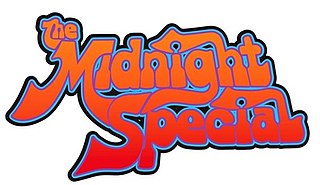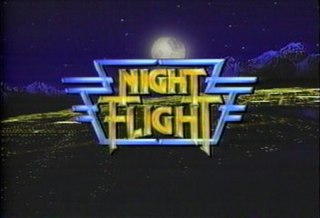
Late Night with David Letterman is an American late-night talk show hosted by David Letterman on NBC, the first iteration of the Late Night franchise. It premiered on February 1, 1982, and was produced by Letterman's production company, Space Age Meats, and Carson Productions. Letterman had previously hosted his own morning talk show on NBC from June to October 1980. The show's house band, The World's Most Dangerous Band, was led by music director Paul Shaffer. In 1993, Letterman announced that he would leave NBC to host the Late Show with David Letterman on CBS. The final episode of Late Night was broadcast on June 25, 1993. The series has continued as Late Night with Conan O'Brien, Late Night with Jimmy Fallon and Late Night with Seth Meyers.
Fridays was a late-night live comedy show that aired on ABC on Friday nights from April 11, 1980, to April 23, 1982.

Second City Television, commonly shortened to SCTV and later known as SCTV Network and SCTV Channel, is a Canadian television sketch comedy show that ran intermittently between 1976 and 1984. It was created as an offshoot from Toronto's Second City troupe. It is an example of a Canadian show that moved successfully to U.S. television, where it aired on NBC in 1981–1983.

MTV2 is an American pay television channel owned by the Paramount Media Networks division of Paramount Global, through PMN’s MTV Entertainment Group Subdivision.

Duncan "Dick" Ebersol is an American television executive and a senior adviser for NBC Universal Sports & Olympics. He had previously been the chairman of NBC Sports, producing large-scale television events such as the Olympic Games and National Football League broadcasts.

Cartoon Planet is an American television programming block that originally ran from 1995 to 1998 and 2012 to 2014 on Cartoon Network. A spin-off of Space Ghost Coast to Coast, the series centered on Space Ghost recruiting his imprisoned evil nemesis Zorak and his loud and dimwitted archenemy Brak to assist him in hosting a variety show.

Nick at Nite is a nighttime programming block on the American basic cable channel Nickelodeon. The programming broadcasts from prime time to late night. The block initially consisted of syndicated sitcoms and films from the 1950s to the 1970s. Nick at Nite gradually shifted its programming to primarily airing sitcoms as recent as the mid-1990s to the 2010s.

Last Call with Carson Daly is an American late-night television series that was broadcast by NBC from 2002 to 2019. Hosted by former MTV personality Carson Daly, the series was initially formatted as a late-night talk show in line with The Tonight Show and Late Night. In 2009, Last Call abandoned its studio-based format, and was retooled as an entertainment program featuring interviews and performances filmed on-location with Daly.
In broadcast programming, dayparting is the practice of dividing the broadcast day into several parts, in which a different type of radio programming or television show appropriate for that time period is aired. Television programs are most often geared toward a particular demography, and what the target audience typically engages in at that time.

BET Soul is an American pay television network that is controlled by the BET Networks division of Paramount Global, which owns the network. The channel showcases R&B, funk, soul, neo soul, hip hop, jazz and Motown music from various decades. The channel uses an automated "wheel" schedule that was introduced during the early years of MTV2 and is also used by sister channel BET Jams. The loop repeats three times a day, starting at 6 a.m. Eastern Time, and then resetting at 2 p.m. and 10 p.m.
Saturday Night Live is an American sketch comedy series created and produced by Lorne Michaels for most of the show's run. The show has aired on NBC since 1975.

Almost Live! was a local sketch comedy television show in Seattle, Washington, USA, produced and broadcast by NBC affiliate KING-TV from 1984 to 1999. A re-packaged version of the show also aired on Comedy Central from 1992 to 1993, and episodes aired on WGRZ-TV and other Gannett-owned stations in the late 1990s. The show was broadcast in Seattle on Saturday nights at 11:30, pushing Saturday Night Live back to midnight, while other Gannett stations aired it after Saturday Night Live.
Late night television is the general term for television programs produced for broadcast during the late evening and overnight hours—most commonly shown after, if not in competition with, local late-evening newscasts; programs that have been showcased in the daypart historically encompassed a particular genre of programming that falls somewhere between a variety show and a talk show. Late-night shows predominantly cater to night owls, people suffering from insomnia, shift workers with irregular schedule assignments, younger male audiences and college students, along with spillover audiences through viewers of entertainment and news programs aired earlier in the evening.
USA Up All Night was an American cable television series that aired weekly on Friday and Saturday nights on the USA Network. The show aired from 1989 to 1998. Throughout its run, the program was hosted by Gilbert Gottfried, Caroline Schlitt, and finally Rhonda Shear.

The Midnight Special is an American late-night musical variety series originally broadcast on NBC during the 1970s and early 1980s, created and produced by Burt Sugarman. It premiered as a TV special on August 19, 1972, and then began its run as a regular series from February 3, 1973, to March 27, 1981. The 90-minute program aired on Saturday mornings at 1 a.m. ET/PT after the Friday night edition of The Tonight Show Starring Johnny Carson.

Night Flight is an online visual-arts magazine and variety television show that originated on cable TV network USA Network. It originally aired from 1981 to 1988 before moving to syndication in the early 1990s. The show relaunched online on nightflight.com in 2015 with original episodes that can be streamed on the subscription channel Night Flight Plus. In April 2018, it returned to cable television as a short form (15-minute) program airing late Friday nights/early Saturday mornings on the network IFC. It includes a mix of mainstream and alternative music videos, artist interviews, B movies, documentaries, short films, stand-up comedy and animation.
City Limits is a Canadian television series, which aired on Citytv and later MuchMusic in the 1980s and 1990s.

Later is a nightly half-hour-long late-night talk show that ran on NBC from 1988 until 2001.

A late-night talk show is a popular genre of talk show, originating in the United States. It is generally structured around humorous monologues about the day's news, guest interviews, comedy sketches and music performances. It is characterized by spontaneous conversation, and for an effect of immediacy and intimacy as if the host were speaking alone to each of the millions of audience members. Late-night talk shows are also fundamentally shaped by the personality of the host, which constitutes the "trademark" of the show.














